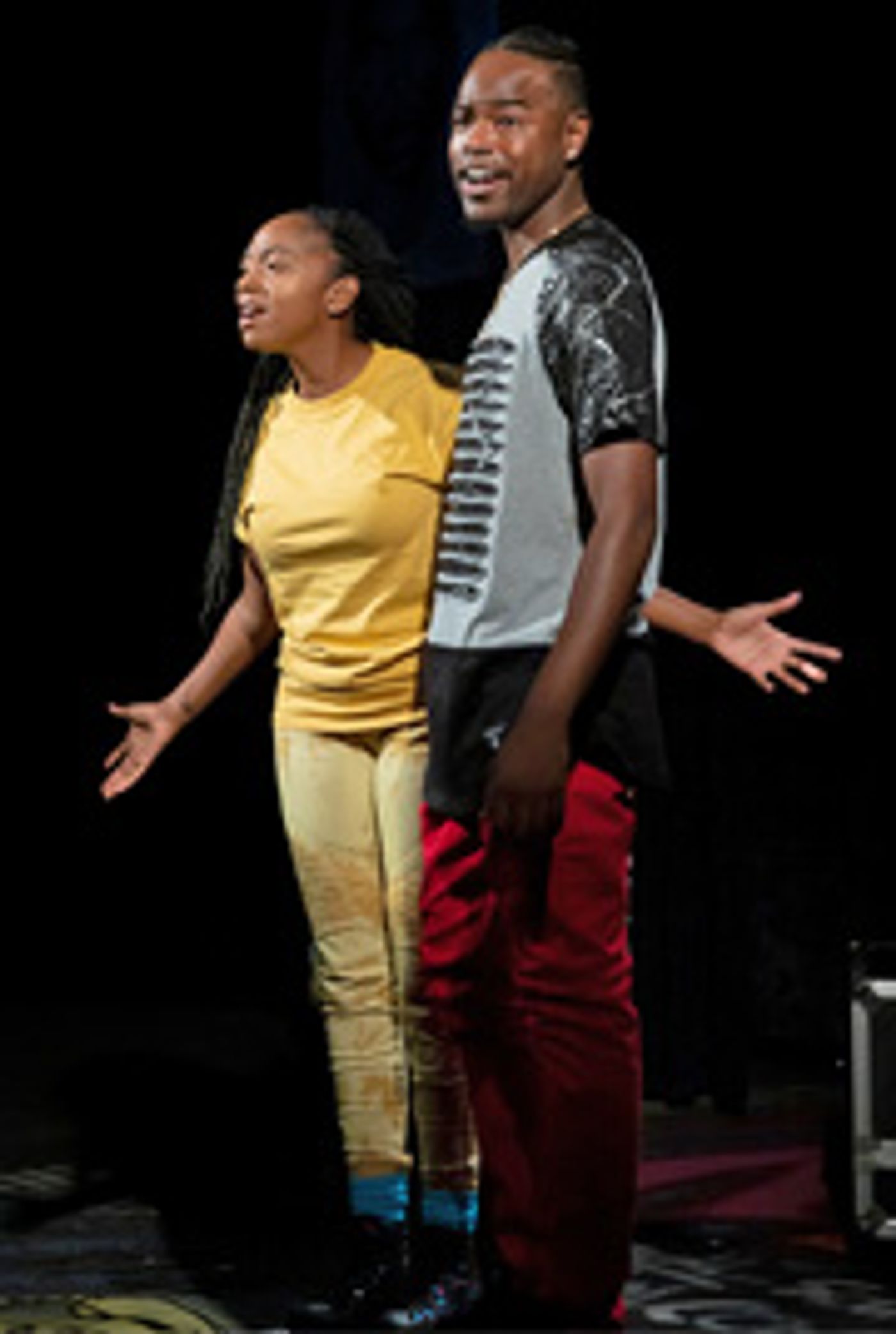Review: RISE UP at The Coterie Theatre
 Opening on Friday night at The Coterie Theatre inside Crown Center is "Rise Up," a four person, seventy five minute play written by British playwright Lisa Evans. The subject is the 1961 "Freedom Riders" project designed by James Farmer's CORE (Congress of Racial Equality). The premise is a group of four contemporary secondary students recount a conflict in the struggle for racial equality in the U.S. for a school age audience.
Opening on Friday night at The Coterie Theatre inside Crown Center is "Rise Up," a four person, seventy five minute play written by British playwright Lisa Evans. The subject is the 1961 "Freedom Riders" project designed by James Farmer's CORE (Congress of Racial Equality). The premise is a group of four contemporary secondary students recount a conflict in the struggle for racial equality in the U.S. for a school age audience.
In 1946, a U.S. Supreme Court decision (Boynton vs Virginia) affirmed the right to unimpeded interstate travel for all Americans. In 1961, CORE assembled a mixed race group of African-American and European-American college students and clergy. This group of "Freedom Riders" boarded buses in Washington D.C. for transport through the old South to New Orleans, LA. En route, the CORE group intended to non-violently challenge post-Civil War Jim Crowe state laws enforcing segregation. Their stated goal was to eliminate separate, but supposedly equal (for whites and coloreds) facilities in transportation related public establishments.
 Although CORE recognized a potential for violence, it undertook the project mainly to enhance the group's profile in comparison to other racial equality organizations and to force action by the new Kennedy administration in Washington. The violent reaction to the 1961 Freedom Ride throughout the old South caused CORE's planned non-violent protest to spin out of control.
Although CORE recognized a potential for violence, it undertook the project mainly to enhance the group's profile in comparison to other racial equality organizations and to force action by the new Kennedy administration in Washington. The violent reaction to the 1961 Freedom Ride throughout the old South caused CORE's planned non-violent protest to spin out of control.
A Greyhound bus is attacked at the bus station in downtown Anniston Alabama, tires were slashed, but the bus was still able to drive out of town. The attackers followed, waiting for the tie air to escape, and for an opportunity to firebomb the bus. The travelers would have likely died in the conflagration if an unexpected gas tank explosion had not driven attackers away. A melee followed -- eventually stopped by a solo Alabama State trooper firing his sidearm into the air.
 A second bus, a Trailways, arrived in Anniston and is attacked, but less severely. It continues to Alabama's largest city Birmingham. Police Chief Bull Connor is already aware that a mob of KKK ruffians awaits the second bus. He agrees to withhold police intervention for fifteen minutes. The Freedom Riders are beaten with bats, pipes, and chains.
A second bus, a Trailways, arrived in Anniston and is attacked, but less severely. It continues to Alabama's largest city Birmingham. Police Chief Bull Connor is already aware that a mob of KKK ruffians awaits the second bus. He agrees to withhold police intervention for fifteen minutes. The Freedom Riders are beaten with bats, pipes, and chains.
It is decided that this kind of violent resistance cannot be allowed to stand. A second group of Freedom Riders embarks from Nashville. This time they are jailed by Connor. The student's passive residence while in custody convinces Police Chief Connor to release them at the Tennessee border under cover of darkness.
By this time, additional civil rights organizations feel compelled to join the protest. A national reaction rises. The Kennedy administration demands safety assurances from Alabama Governor Patterson. He and other Southern Governors double-cross the Kennedy Brothers and the chaos continues in the next state. U.S. Marshall arrive in time to end violence at a Montgomery Alabama Church with Martin Luther King, Jr. as one of the trapped.
More than three hundred Freedom Riders are eventually imprisoned in the Mississippi State Penitentiary. In September 1961, Robert Kennedy's petition to the Interstate Commerce Commission results in new, enforceable policies to cure some of the protester's demands. ICC rules make segregated buses, trains, terminals, drinking fountains, toilets, waiting rooms, and lunch counters relics of an ugly past.
The persistence and final victory of the Freedom Riders encourages other groups to advocate for further goals and objectives. The waves of violence and non-violent resistance impress the nation and give birth to movements that continue to this day.
Playing multiple roles in explaining this important and complex history are Catera Combs, Khrystal L. Coppage, Jay Love, and Jordan Luty. The play is directed by Coterie Artistic Director Jeff Church with set designs by Rafael Toribio.
I am fortunate enough to have experienced some of the civil rights movement in the 1960s and 70s from afar. I was already in radio when John Kennedy was assassinated and days later watched his murderer killed in the basement of the Dallas Police Station on live TV. I remember the killings of Robert Kennedy and Martin Luther King Jr. I was present as a member of the working press at the 1968 Chicago riots and the Democratic Convention during that same year.
Times have changed mostly for the better, but challenges posed by today's political gridlock make it essential to retell the stories so they are never forgotten. Civil Rights can all be made to go away if we forget how we got here.
The show is often followed by a talk back and an opportunity to participate with the actors.
"Rise Up" continues at The Coterie through October 20 on the lower level of Crown Center. Tickets are available at www.thecoterie.org or by telephone 816-474-6552. "Rise Up" may be performed multiple times each day so it suggested that audience members check the entire schedule on the website.
Photo by Erin Stricker and courtesy of The Coterie Theatre.
Opening on Friday night at The Coterie Theatre inside Crown Center is "Rise Up," a four person, seventy five minute play written by British playwright Lisa Evans. The subject is the 1961 "Freedom Riders" project designed by James Farmer's CORE (Congress of Racial Equality). The premise is a group of four contemporary secondary students recount a conflict in the struggle for racial equality in the U.S. for a school age audience.

"Rise Up" at the Coterie Theatre
In 1946, a U.S. Supreme Court decision (Boynton vs Virginia) affirmed the right to unimpeded interstate travel for all Americans. In 1961, CORE assembled a mixed race group of African-American and European-American college students and clergy. This group of "Freedom Riders" boarded buses in Washington D.C. for transport through the old South to New Orleans, LA. En route, the CORE group intended to non-violently challenge post-Civil War Jim Crowe state laws enforcing segregation. Their stated goal was to eliminate separate, but supposedly equal (for whites and coloreds) facilities in transportation related public establishments.
Although CORE recognized a potential for violence, it undertook the project mainly to enhance the group's profile in comparison to other racial equality organizations and to force action by the new Kennedy administration in Washington. The violent reaction to the 1961 Freedom Ride throughout the old South caused CORE's planned non-violent protest to spin out of control.
A Greyhound bus is attacked at the bus station in downtown Anniston Alabama, tires were slashed, but the bus was still able to drive out of town. The attackers followed, waiting for the tie air to escape, and for an opportunity to firebomb the bus. The travelers would have likely died in the conflagration if an unexpected gas tank explosion had not driven attackers away. A melee followed -- eventually stopped by a solo Alabama State trooper firing his sidearm into the air.
A second bus, a Trailways, arrived in Anniston and is attacked, but less severely. It continues to Alabama's largest city Birmingham. Police Chief Bull Connor is already aware that a mob of KKK ruffians awaits the second bus. He agrees to withhold police intervention for fifteen minutes. The Freedom Riders are beaten with bats, pipes, and chains.
It is decided that this kind of violent resistance cannot be allowed to stand. A second group of Freedom Riders embarks from Nashville. This time they are jailed by Connor. The student's passive residence while in custody convinces Police Chief Connor to release them at the Tennessee border under cover of darkness.
By this time, additional civil rights organizations feel compelled to join the protest. A national reaction rises. The Kennedy administration demands safety assurances from Alabama Governor Patterson. He and other Southern Governors double-cross the Kennedy Brothers and the chaos continues in the next state. U.S. Marshall arrive in time to end violence at a Montgomery Alabama Church with Martin Luther King, Jr. as one of the trapped.
More than three hundred Freedom Riders are eventually imprisoned in the Mississippi State Penitentiary. In September 1961, Robert Kennedy's petition to the Interstate Commerce Commission results in new, enforceable policies to cure some of the protester's demands. ICC rules make segregated buses, trains, terminals, drinking fountains, toilets, waiting rooms, and lunch counters relics of an ugly past.
The persistence and final victory of the Freedom Riders encourages other groups to advocate for further goals and objectives. The waves of violence and non-violent resistance impress the nation and give birth to movements that continue to this day.
Playing multiple roles in explaining this important and complex history are Catera Combs, Khrystal L. Coppage, Jay Love, and Jordan Luty. The play is directed by Coterie Artistic Director Jeff Church with set designs by Rafael Toribio.
I am fortunate enough to have experienced some of the civil rights movement in the 1960s and 70s from afar. I was already in radio when John Kennedy was assassinated and days later watched his murderer killed in the basement of the Dallas Police Station on live TV. I remember the killings of Robert Kennedy and Martin Luther King Jr. I was present as a member of the working press at the 1968 Chicago riots and the Democratic Convention during that same year.
Times have changed mostly for the better, but challenges posed by today's political gridlock make it essential to retell the stories so they are never forgotten. Civil Rights can all be made to go away if we forget how we got here.
The show is often followed by a talk back and an opportunity to participate with the actors.
"Rise Up" continues at The Coterie through October 20 on the lower level of Crown Center. Tickets are available at www.thecoterie.org or by telephone 816-474-6552. "Rise Up" may be performed multiple times each day so it suggested that audience members check the entire schedule on the website.
Photo by Erin Stricker and courtesy of The Coterie Theatre.
Reader Reviews
Videos

